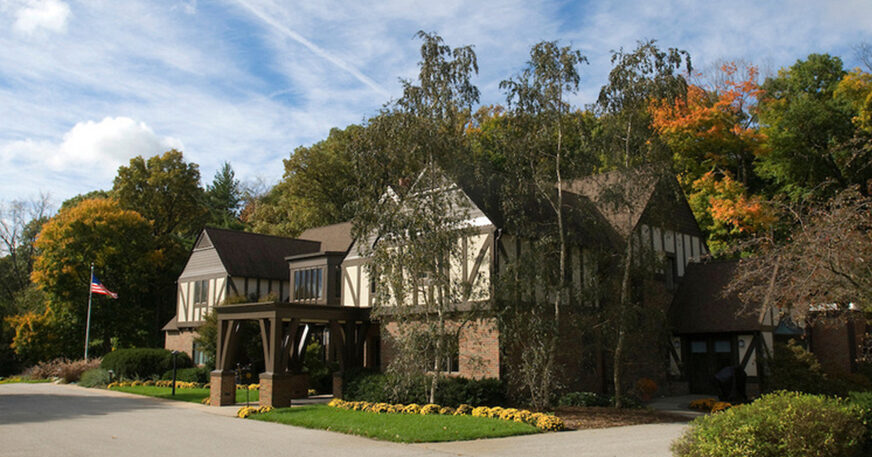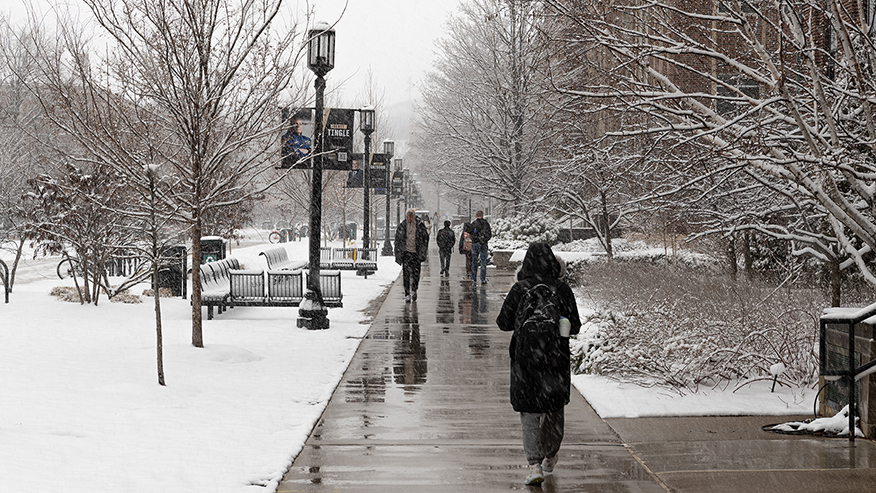Strength of Purdue’s pharmacy graduate program felt in improved lives, purposed service, rewarding careers in health care

Grace Oeding of Evansville, in the final year of her studies in Purdue’s doctor of pharmacy (PharmD) program, works at the Purdue University Pharmacy in the Robert E. Heine Pharmacy Building. (Purdue University photo/Charles Jischke)
About This Series: This story is part of an ongoing Purdue Today series highlighting programs ranked in the Top 10 or Top 10th percentile among our peers nationally, demonstrating the university’s persistent pursuit of excellence, innovation and transformative learning.
As the link between patients and medicine, pharmacists today must be experts on prescription drugs and over-the-counter medications, understanding use, side effects and mixtures of medicine. If not at that patient connection point, they are in the research laboratories, assisting in the development of next-generation medication in preventing illnesses or treating cancer and chronic diseases such as diabetes and arthritis.
Few university programs across the nation better equip the next generation of pharmacists, pharmaceutical researchers and groundbreaking drug discovery and development leaders than Purdue University’s College of Pharmacy. The Purdue graduate program is ranked No. 7 in the most recent U.S. News & World Report list, which was compiled in 2020 and included 134 schools and programs offering Doctor of Pharmacy degrees accredited by the Accreditation Council for Pharmacy Education.
“Purdue’s passionate commitment to world-changing research and transformative education is well reflected in its wide variety of pharmacy programs,” says Eric Barker, the Jeannie and Jim Chaney Dean of Pharmacy. “Add up all the ingredients to the Purdue difference — top-notch teachers, cutting-edge research facilities, and a broad variety of pharmacy programs with up-to-the-minute curricula flexible enough to prepare students for almost any career path in the field of pharmacy — and you’ll see that Purdue offers students unparalleled opportunities in pharmacy education.”
Additional Information

Supported by a distinguished faculty, state-of-art facility and productive collaborations within the pharmaceutical industry, Purdue’s pharmacy program nurtures its students’ academic ambitions with many initiatives. Those include an innovative professional curriculum and strategic alliances at the local, regional and international levels.
Purdue offers a four-year Doctor of Pharmacy (PharmD) program, designed to prepare students to excel in the field of pharmacy. The program is based on an integrated approach with the right emphasis on classroom, lab and experiential learning, ensuring students not only have a strong foundation but also gain valuable hands-on experience.
Purdue’s PharmD program has over 85 faculty. The school is especially renowned for its research in pharmaceutical development, and the PharmD has a significant laboratory component.
Working as a research scientist at Chicago-based biopharmaceutical firm AbbVie Inc., Alex Deac enjoyed the fast-paced environment where he formulated products for clinical trials and developed life-cycle improvements for Duopa, a prescription medication used for treatment of advanced Parkinson’s disease. Although he loved the work, in his five years at the bench he noticed scientific gaps related to poorly soluble drugs.
Now a graduate research assistant at Purdue, Deac works with Lynne Taylor, the Retter Distinguished Professor of Pharmacy and a world-renowned expert in enhancing the delivery, efficacy and safety of drugs. The Taylor Lab, part of the newly renamed Department of Industrial and Molecular Pharmaceutics, explores the fundamental science underlying the preformulation, formulation and manufacturing of drugs.
“Industry really focuses on the development of pharmaceuticals,” says Deac, a 2023 PharmD graduate.
“While they do research, they’re more focused on bringing APIs (active pharmaceutical ingredients) to market. The fundamental science behind the properties of a formulation is more the realm of academia. That’s why I wanted to pursue a PhD at Purdue — to gain more fundamental knowledge behind key formulation properties and try to push the field forward.”
Nearly two-thirds of all pharmacists in Indiana graduated from Purdue’s College of Pharmacy, which was established in 1884 and is the nation’s third-oldest state-funded school of pharmacy.

The role pharmacists play today in the health care industry continues to grow. Their contributions go beyond a pharmacy as they take up more challenging work such as research and drug discovery. As of 2021, there are 312,550 pharmacists working in the country earning an annual average salary of $125,690.
Like many other pharmacy colleges, Purdue subscribes to the idea of experiential learning within its four-year PharmD curriculum. All told, experiential learning consists of 30% of the curriculum over the span of the entire program.
Students get hands-on experience beginning in their first year and complete different rotations during their four years. And graduates of this program find employment in well-known organizations or can go on to pursue graduate level studies. In addition to the PharmD program for aspiring pharmacists, Purdue also offers a suite of graduate programs, including:
- Doctorate in Industrial and Physical Pharmacy
- Master in Medicinal Chemistry and Molecular Pharmacology
- Master in Pharmacy Practice
Purdue’s pharmacy coursework includes subjects such as pharmacy skills and patient counseling, pathophysiology and drug action, pharmaceutical calculations, integrated pharmacotherapy, dosage forms, health care systems, public health pharmacy, pharmacogenomics, population health management, biotech/advanced parenteral dosage forms, patient safety and informatics, and health policy applications jurisprudence.
During a fourth and final year over a period of 11 months, Purdue pharmacy students participate in 10 four-week rotations at pharmacy settings, providing an opportunity to put knowledge and skills to use while gaining real-world experience.
Another factor in Purdue pharmacy success, students in the program have fared well on the North American Pharmacist Licensure Examination, or NAPLEX, which is designed to evaluate general practice knowledge by recent graduates for licensing by the boards of pharmacy. Pass rates for the last 10 years by Purdue pharmacy graduates have ranged from a high of 98.7% to 85.7%, with the pass rate above 93% in eight of those years.
Brianna Arinze, who is entering her second year at Purdue, said she chose the university because of its commitment to affordability — and the strength of its pharmacy program. She also had a personal motivation for this career path. When her triplet sister started losing patches of hair at a young age, Arinze felt helpless. Alopecia, an autoimmune disorder that can cause baldness, affects nearly one-third of Black women in the U.S.
“I knew I’d be getting a high-quality education,” Arinze says. “The Purdue pharmacy program has a reputation of being challenging, but I like to be challenged. I also knew I would receive support when I needed it. Purdue seemed like the perfect fit for me.”
In addition, the Purdue college is home to the Center for Medication Safety Advancement and the Center for Pharmaceutical Processing Research. It is the only pharmacy program in the nation with faculty sited abroad and the only program to offer global health and veterinary clinical pharmacy postgraduate residencies.
Purdue clinical assistant professor Jamie Woodyard says she strikes a balance in her classrooms and labs, stressing the value of students learning from their mistakes while underscoring the consequences of errors in dispensing medicine for patients in the real world.
“This approach has helped me connect better with students on a human level,” says Woodyard, a 2011 Purdue PharmD alumna. “It also helps to demonstrate the laboratory as a safe space where students can make mistakes, reflect, acknowledge and learn from them, and then to think through how to prevent these mistakes from occurring again when they are practicing pharmacists.
“I smile a lot in my classes because I truly love what I do. I suppose my secret in pursuing excellence as a teacher is to keep students at the center of everything I do,” Woodyard adds.
Earlier this year, Purdue’s colleges of Pharmacy and Health and Human Sciences announced joint plans for a giant academic leap to advance collaborative, innovative learning for health care professionals in Indiana through a $160 million modern campus facility.
“The Nursing and Pharmacy Education Building is paramount to preparing students to stay on the forefront of our ever-changing health care system and to serve as leaders in their field for generations to come,” Barker says. “The roles of pharmacists and nurses have rapidly changed, with both serving central roles in the delivery of patient care. This hub on Purdue’s campus will help drive students forward in their persistent pursuit of bettering human health.”
Writer: Phillip Fiorini, pfiorini@purdue.edu
Contributing: Kat Braz, skatbraz@gmail.com



